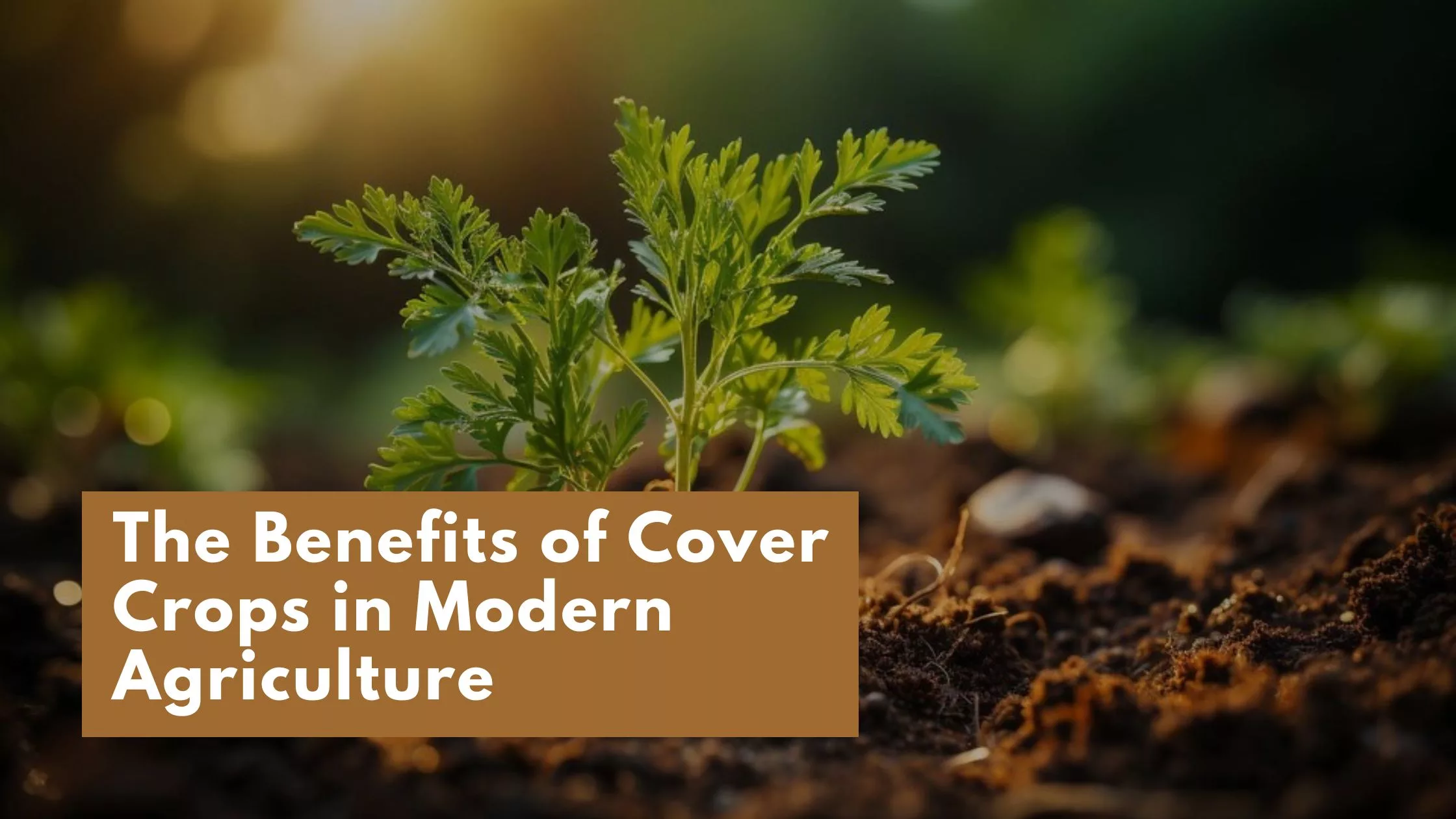Introduction
Due to their multiple advantages and contributions to sustainable farming techniques, cover crops have received great prominence and significance in modern agriculture. These crops provide a variety of functions outside of regular crop production. They are often grown in between cash crop cycles or during fallow times. Cover crops are essential to avoid soil erosion, enhance soil health, manage nutrients, control weeds, improve water management, encourage biodiversity, and lessen the effects of climate change.
An efficient method for tackling environmental issues, enhancing soil fertility, and minimizing the dependency on synthetic inputs is the incorporation of cover crops into agricultural systems. Farmers may achieve long-term sustainability and productivity by incorporating cover crops into their agricultural practices by having a clear awareness of their significance and benefits.
This article will examine the value of cover crops in contemporary agriculture, emphasizing their advantages, methods for preventing erosion, and function in fostering resilient and long-lasting agricultural systems. Farmers and stakeholders can use the potential of cover crops to increase agricultural output while preserving natural resources and reducing environmental effects by understanding their significance.
Benefits of cover crops in modern agriculture
In contemporary agriculture, cover crops offer several advantages that support efficient and profitable agricultural methods. These are a few of the main benefits of cover crops:
Improvement of soil health:
Cover crops are essential for preserving and promoting soil health. Their extensive root systems improve soil fertility, organic matter content, and structure. Cover crops help preserve vital topsoil for maintaining long-term agricultural output by avoiding soil erosion.
Nutrient management:
Cover crops aid in the control of nutrients in agricultural systems. They reduce the chance of nutrients seeping into water bodies by absorbing excess nutrients from the soil, especially nitrogen, phosphorus, and potassium. These nutrients are released when cover crops are cut down and absorbed into the soil, making them accessible for succeeding crops. This encourages practical nitrogen cycling and lessens the need for commercial fertilizers.
Suppression of weeds:
Crops serve as organic weed suppressors by competing with weeds for resources like light, water, and nutrients. Weeds are shaded out by the dense canopy that covers crops produced, which inhibits their growth and keeps them from getting entrenched. This lowers the need for chemicals and physical weed management, saving money and having less negative impact on the environment.
Management of pests and diseases:
Some cover crops emit organic substances that aid in thwarting pests and illnesses. For instance, certain crops release compounds called allelopathic that prevent soil-borne diseases and pests from growing. Crops also offer a home for helpful insects, birds, and other creatures that aid with biological pest management. Crops can reduce the demand for chemical pesticides by lowering insect and disease burdens.
Water management:
By enhancing water infiltration and lowering runoff, crops can help to prevent soil erosion and nutrient loss. Their extensive root systems increase the soil’s capacity to retain water, which benefits agricultural yields and water availability. Crops help preserve soil moisture and increase water usage efficiency, which is especially advantageous during dry spells or in areas with few water supplies.
Climate adaptability:
Cover crops can help agricultural systems adapt to changing climates. By removing carbon dioxide from the atmosphere and storing it as organic matter in the soil, they aid in reducing the effects of climate change. As a result, greenhouse gas emissions are decreased, and soil carbon sequestration is improved, helping in the fight against climate change.
Conservation of biodiversity:
Cover crops offer homes and food for helpful insects, birds, and other species. They promote biodiversity by luring pollinators, pests’ natural enemies, and soil microbes. Enhanced ecosystem services, improved ecological balance, and improved farm resilience benefit from increased biodiversity in agricultural environments.
Crop rotation and diversification:
Including cover crops in crop rotation programs can help break the cycles of pests and disease, lower weed pressure, and enhance soil fertility. Additionally, crops offer a chance to diversify agricultural output by enabling farmers to grow new or alternative cash crops that can increase economic value and lessen reliance on a single crop.
Overall, incorporating cover crops into contemporary agriculture has several advantages, such as better soil health, nutrient management, weed control, pest and disease management, water saving, climate resilience, biodiversity preservation, crop rotation, and crop variety. Farmers may use these benefits to encourage resilient and sustainable agricultural methods while increasing production and practicing environmental stewardship.
Examples of cover cropping in agriculture
Agricultural cover crops can be used in various ways, with the choice being influenced by the climate, soil type, cropping method, and particular goals. The following are a few typical instances of cover crops used in agriculture:
Legumes:
- Clover (e.g., crimson clover, red clover, white clover)
- Alfalfa
- Field peas
- Hairy vetch
- Lentils
Grasses:
- Ryegrass (e.g., annual ryegrass, cereal rye)
- Oats
- Barley
- Wheat
- Annual or perennial grass mixes
Brassicas:
- Mustard
- Radish (e.g., oilseed radish, daikon radish)
- Turnips
- Rapeseed
Others:
- Buckwheat
- Sunflower
- Phacelia
- Sorghum-sudangrass
- Annual clover-grass mixes
How do cover crops prevent soil erosion?

Crops play a crucial part in avoiding soil erosion by utilizing some processes that safeguard the soil surface and enhance its stability. The following are some ways that cover crops can stop soil erosion:
Physical barrier:
Cover crops’ aboveground biomass, including their leaves, stems, and branches, creates a physical barrier that protects the soil from wind and rain. This barrier lessens the force of raindrops as they fall and reduces their capacity to separate and move soil particles. Crops minimize erosion by catching rain before they form crusts on the soil’s surface or move soil particles.
Ground cover:
Cover crops provide ground cover with thick foliage, effectively shading the soil surface. Raindrops are not as directly impacted by the shade, spreading the energy and preventing soil splash and separation. Crops lessen the amount of soil splash by which soil particles are carried by surface runoff.
Root systems:
Crops produce extensive root systems that hold the soil together. The soil’s structure and stability are improved due to the roots’ penetration, which leads to the formation of channels and the binding of soil particles. The linked network of roots strengthens the soil, making it more resistant to erosion brought on by wind and water.
Increased infiltration:
Infiltration capacity is improved by crops’ root systems, which enable water to permeate the soil rather than flow off the top. Consequently, less surface runoff and related erosion occur because the soil absorbs the water. Additionally, the enhanced penetration encourages water retention in the root zone for succeeding crops and replenishes the soil’s moisture content.
Enhanced aggregation:
Soil aggregates are collections of soil particles bound together by organic matter and microbial activity. Cover crops help to generate and maintain these aggregates. Crop roots release compounds that encourage the development of beneficial soil microbes, promoting the formation of soil aggregates. These aggregates are more erosion-resistant because they offer superior structural integrity and lessen the likelihood of soil particles detaching.
Effect of a windbreak:
In windy areas, crops serve as windbreaks, slowing the speed of the wind near the soil surface. This windbreak effect reduces the wind’s erosive force and stops soil particles from moving. Cover crop vegetation is thick, which reduces wind erosion and helps to disperse wind energy.
By combining these methods, cover crops efficiently reduce soil erosion by lowering soil particle detachment, reducing surface runoff, strengthening soil stability, and improving soil structure. Their usage in agricultural systems encourages sustainable land management techniques and helps preserve essential topsoil.
Conclusion
In conclusion, cover crops are essential in modern agriculture because they offer a variety of advantages, such as reducing soil erosion. Cover crops successfully stop soil erosion by serving as physical barriers, providing ground cover, and growing deep root systems. They promote soil structure and stability, prevent splash and separation, shield the soil surface from wind and rain, and improve water penetration.
Utilizing crops supports robust and sustainable agricultural practices while preserving critical topsoil. Farmers may prevent soil erosion, maintain soil fertility, control nutrients and pests, save water, and support biodiversity conservation by using cover crops in their agricultural systems. Crops are generally a helpful technique for sustainable land management. Cover crops are valuable for contemporary agriculture’s sustainable soil protection and land management.




Examples of cover cropping show just how versatile and effective it can be.
I found the details on how cover crops manage pests really enlightening.
Cover crops not only improve soil health but also support sustainable farming.
It’s great to see practical solutions like cover cropping being highlighted.
This post did a great job explaining the multiple benefits of cover crops.
Cover crops are clearly a game-changer for modern farming techniques.
The prevention of soil erosion through cover crops is fascinating.
Loved reading about the various examples of cover cropping in action.
The section on pest and disease management was super informative.
I never realized cover crops could benefit agriculture in so many ways.
Cover crops seem like such a simple yet powerful tool for farmers.
It’s amazing how cover crops help prevent soil erosion – great read!
Learning about different examples of cover cropping was really interesting.
I had no idea cover crops could be so effective at managing pests and diseases!
This post really highlighted how cover crops can improve modern agriculture – loved it!
Understanding how cover crops prevent soil erosion is crucial – well done!
The post does a great job illustrating various cover cropping techniques.
It’s fascinating to see how cover crops can enhance pest and disease control.
Cover crops offer so many benefits to modern agriculture – great insights!
The explanation of soil erosion prevention with cover crops is excellent.
The detailed examples of cover cropping are very helpful and practical.
Managing pests and diseases with cover crops is such an innovative approach.
The advantages of using cover crops in modern agriculture are well-presented.
Learning about how cover crops prevent soil erosion was very enlightening.
The post provides a lot of useful examples of cover cropping practices.
It’s impressive to see how cover crops can improve pest and disease management.
The benefits of cover crops in modern farming are clearly explained here.
Cover crops are such a great way to prevent soil erosion – very informative read!
The examples of cover cropping in agriculture are very inspiring.
It’s amazing how cover crops can help manage pests and diseases so effectively.
This blog post highlights the incredible benefits of cover crops in modern agriculture!